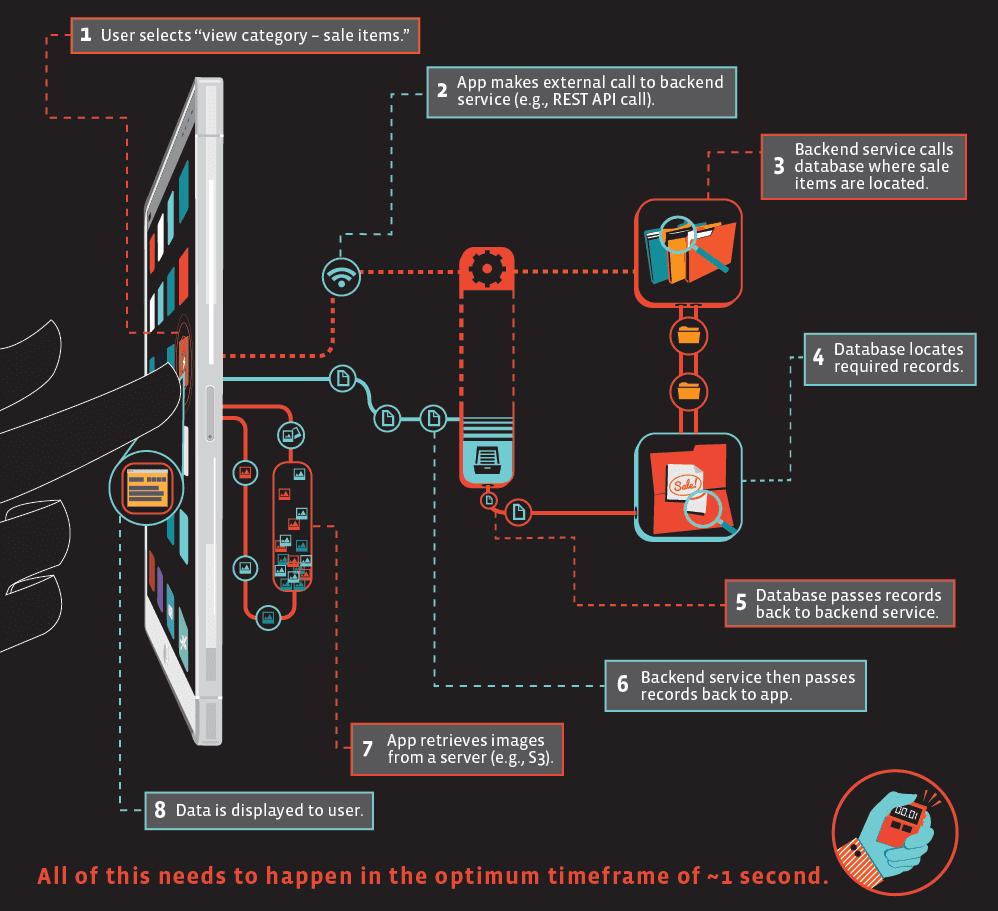Loading behind the scenes of Mobile Apps
It’s easy to test mobile apps in ideal conditions. But reality doesn’t always give us a full battery and strong Wi-Fi.
Did you know that 75% of mobile users delete an app if it freezes or crashes?
How does an app work…?
Let’s take an example of a m-commerce application. When a customer accesses the app, great things happen

1.86% Average network request failure rate per minute per app
1.7% average server error rate per minute per app
Lots of Users Can Mean Lots of Errors
Maximum number of web service requests in an app’s busiest minute: 836,000
for an app with 35,600 active users at the time.
With a 1.86% average network request failure rate, your app could experience 15,550 failed network requests in a minute.
At a 1.5% average server error rate,
it could experience 14,200 server errors in a minute!
Mobile app testing is affected by challenges arising due to huge differences in network, devices and OS, not to mention differences in user skills. Adding to it, the need for better video and audio capabilities and hand gesture based applications, it is imperative that a mobile app delivers on all counts!
Across Various devices and Platforms, Indium is your one stop solution. Click here to learn more about our Mobile App Testing Services
Mobile app Testing
To get the much desired five star ratings, an app needs to rise above these challenges and deliver high performance under varying environments of usage.
Below are certain best practices, when followed meticulously, can ensure a mobile app is truly adaptable.
Devise a Testing Strategy:
Developing a strategy that helps to lay down certain guiding principle, which all testers are expected to follow. This brings standardization in testing and ensures adequate test coverage.
Perform Testing on Real Mobile Devices:
Of course, emulators and simulators are really convenient in the early stages of mobile app development, but the app needs to be tested adequately on real devices too. This ensures realistic test results and gives the tester a better idea regarding the look and feel of the app and its general usability. Also, emulators don’t take hardware into consideration.
Indium’s mobile testing labs is equipped with 350+ devices
- Testing in Parallel with Development: Start testing in parallel with testing jumpstart kits. This helps to identify issues early before they become too costly to fix. Track results of each test cycle.
- Device and OS preferences: It might be virtually impossible to test thoroughly on all device, network and OS mishmashes. perform QA on the devices and OS the app will specifically cater to.
- Mobile Test Automation: A mobile test automation framework like iMobi that comes with comprehensive reusable test case repository, can significantly shrink the time to market and maximize ROI. But a key aspect to keep in mind is periodic maintenance of the automation test suite.
- Stress, security and Performance testing: Performance, stress and security testing make the app robust and can prevent financial liabilities arising from user anguish. Known and unknown vulnerabilities should be checked, including those arising from third party and open source software packages.
- Check battery consumption, fault tolerance and interoperability: Power starving apps most likely get deleted by the users. Power consumption by the app should be checked and monitored regularly. Also, the performance of the application should be checked in negative conditions like varying network strengths or suspended connections; and when the app runs parallel with other apps.
- App Localization: Ensure that the app supports multiple languages, currencies and even popular social networks of prominent markets.
There is nothing worse than an app that loads slowly or crashes frequently.
50% users who encounter a bug never return. Selecting an appropriate testing partner to grow with can make the difference between success and failure for your app.
Establish confidence in the behavior of your mobile applications across devices & platforms by leveraging Indium’s Mobile App Testing Services.
Working on the same topic? Have suggestions? Please comment below…






